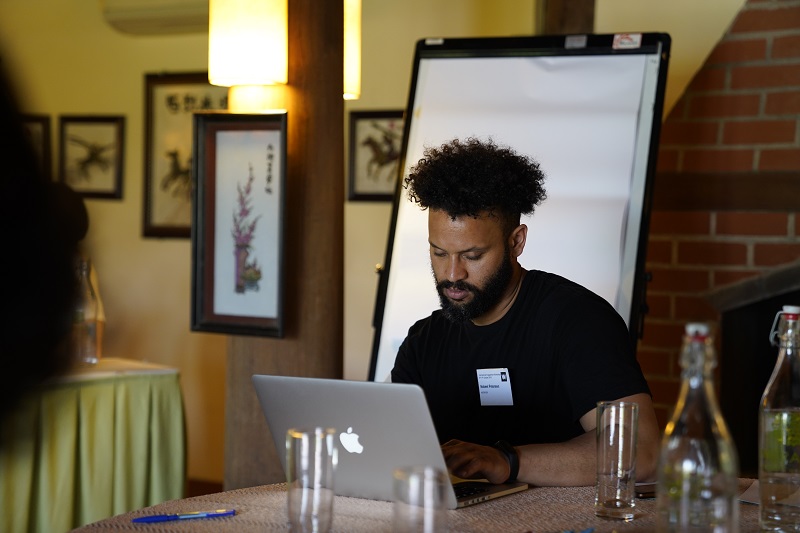Community and public engagement (CPE) should, by definition, seek to include as many groups with diverse experiences and realities as possible. However there is currently a lack of representation of certain groups in CPE communities and activities. Which groups are excluded will differ in certain contexts; in the UK, this includes people from ethnic minority backgrounds, people on low incomes or disabled people. A group session at the 2018 Wellcome International Engagement Workshop explored this issue; symbolically, many of these excluded groups were not represented at the workshop, exemplifying how they are often left out of conversations about their inclusion.
Nabeel Peterson, a Wellcome Engagement Fellow, was one of the speakers leading this session. After growing increasingly frustrated with the positionality of beneficiaries of public engagement and other programmes, Nabeel sought to explore alternative inclusive and participatory models. His unconventional methods seek to firstly establish a team and allow the team to co-design processes. This, by default, defies replicability and scaling. Nabeel relies on and strives to include community-relevant and sensitive approaches that are context specific.
Nabeel led the South African component of a Wellcome funded, multi-country, mental health public engagement initiative titled Arting Health for Impact. The Botswanan component was led by Abraham Mamela and the Indian component by Sarah Iqbal. Nabeel presented this project to those in the inclusivity group session.
Nabeel is interested in alternative models of running public engagement activities to involve as diverse an audience as possible. As a means of exploring inclusive and participatory approaches to CPE, Nabeel initiated a relationship with the Lentegeur Psychiatric Hospital, South Africa, and its resident NGO the Spring Foundation. His intention was to design the project as a team, across the various organisations. The focus was to further explore the decision-making, outcomes and impact of co-designed events, activities and processes that hold all participants on an egalitarian platform.
The project began with meetings with a range of organisations and individuals working on Mental Health. After securing their interest and the participation of clinical psychiatrists, clinical psychologists, clinical nurses, clinical occupational therapists and clinic security he sought a similar approach to securing interested youth patients for inclusion. This process was guided by the clinical staff, while in-patients, out-patients and youth with learning disabilities were consulted. A key challenge was attempting to disperse and reduce power imbalance within the team. Excursions were organised which allowed participants to be immersed in each other’s worlds and the team visited both local street art exhibitions to gain an understanding of its potential as an engagement medium a science museum to understand more conventional engagement. This was followed by storytelling workshops, ahead of a participatory co-design process to design a mural and a public engagement event on the hospital premises.
The team, including youth, clinical staff and artists co-designed the mural and its messaging, as well as all logistics concerning the event. The participants collectively decided on décor, refreshments, activities, invitation structure and took on specific responsibilities on the day. The event focused on mental health and managing mental health. The youth decided that it was necessary to avoid standard pedagogy and focus on management methods or techniques including yoga; a science museum exhibition; music; spoken word; meditation; mindfulness; flow arts; self-coping mechanisms; gardening and greater opportunity to talk openly to scientists researching mental health.
By providing youth with the opportunity and confidence to guide and lead these processes, their voices were central, elevated and amplified; their needs and wants were centre stage. The greatest success of the project was visible when compared with the hospital’s previous attempts at engagement. In prior events focused on destigmatisation and rehabilitation, the hospital managed to secure a maximum of 15 people per event. By allowing youth to direct their own processes and co-design the event they secured the attendance of approximately 400.
Additional successes include: the continual interest by the hospital and clinical executive committee. The hospital now allows staff a finite number of days per month for engagement practice, which never existed before, and allows young people onto the government facility. Sharing between Nabeel’s team and Occupational Therapists on arts methods was also a positive outcome as were the development of soft skills by youth and clinical staff. The output of a large public mural co-design by youth, scientists and artists can be seen from the outside of the hospital and will remain there for the long-term.
Nabeel credits the success of the project to a model which is focused on co-design, participation, inclusion and transparency.
---
The content on this page forms part of the online report for the 2018 International Engagement Workshop “Taking it to the Next Level: How can we generate leadership and develop practice in engagement?". To learn more about the workshop, access the rest of the report and browse the video presentations, discussion summaries, and tools, visit the workshop page.

This work is licensed under a Creative Commons Attribution 4.0 International License.


Please Sign in (or Register) to view further.